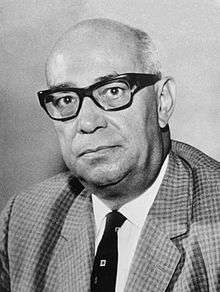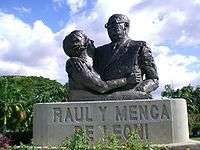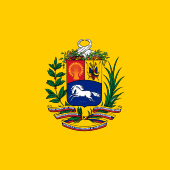Raúl Leoni
| Raúl Leoni | |
|---|---|
 | |
| President of the Republic of Venezuela | |
|
In office 13 March 1964 – 11 March 1969 | |
| Preceded by | Rómulo Betancourt |
| Succeeded by | Rafael Caldera |
| Senator for life | |
|
In office 11 March 1969 – 5 July 1972 | |
| President of the National Congress of Venezuela | |
|
In office 1959–1962 | |
| Minister of Labor of Venezuela | |
|
In office 1945–1948 | |
| Personal details | |
| Born |
Raúl Leoni Otero 26 April 1905 El Manteco, Bolívar State, Venezuela |
| Died |
5 July 1972 (aged 67) New York City, New York, U.S. |
| Political party | Acción Democrática |
| Spouse(s) | Carmen América Fernández Alcalá (Menca de Leoni) |
| Religion | Roman Catholic |
| Signature |
|
Raúl Leoni Otero (26 April 1905 – 5 July 1972) was President of Venezuela from 1964 until 1969. He was a member of the Generation of 1928 and a charter member of the Acción Democrática party, and the first Labor minister of Venezuela (during El Trienio Adeco, 1945–48).
Background
Leoni was born in El Manteco, Bolívar State, son of a mason born in Corsica. He graduated at the Central University of Venezuela in Caracas as a lawyer. He was a member of the Generation of 1928, and the first Labor minister of Venezuela (during El Trienio Adeco, 1945–48).
Presidency

Leoni took control of the presidency on 13 March 1964, succeeding Rómulo Betancourt; both were members of the Acción Democrática.
One of the pillars of a political consolidation in Venezuela, the Pacto de Punto Fijo, was underestimated by Leoni, since in his opinion it reduced the "coherence and organization of the regime". Strictly, the pact mandated that the composition of the executive cabinet be limited to representatives of three of the more important political parties: Acción Democrática (AD), COPEI and Unión Republicana Democrática (URD). Leoni initially formed a cabinet with a few members of his party and a good number of independents. Later, in November 1964, Leoni initiated conversations with leaders of the involved parties to rescue the spirit of the pact. A new cabinet was formed, but it lasted for only 16 months.
During his government, Leoni carried out important structural projects in Venezuela, specifically the development of heavy industry in Guayana (hydroelectric, iron and steel), inauguration of the Bank of the Workers, and construction of road infrastructure (highways, freeways, and bridges – the most important of which crossed the Orinoco). Important changes to labor and social programs also occurred; unions gained force and the Social Security law was modified. Leoni made an attempt at reforming tax structure, but was restrained by a coalition of left and right that openly served the interests of oil companies.
In 1967 the Invasion of Machurucuto happened during the presidency where 12 guerrillas attempted to help Venezuelan guerrillas in the Venezuelan Andes.
Also, in this same period Leoni signed the Cartagena Agreement (precursor to the Andean Community trade bloc) in Bogotá between Venezuela, Chile, Colombia, Perú and Ecuador.
During Leoni's presidency the conflict with the leftist guerrilla movement Armed Forces for National Liberation (FALN) intensified. In 1967 he suspended constitutional guarantees.
On 11 March 1969, Leoni transferred power to Rafael Caldera, member of the Christian Democratic Party COPEI and signatory of the Pacto de Punto Fijo. This transfer definitively instituted the alternation of power between the important parties through the end of the 20th century in Venezuela.
Raúl Leoni's cabinet
| Ministries [1] | ||
|---|---|---|
| OFFICE | NAME | TERM |
| President | Raúl Leoni | 1964–1969 |
| Home Affairs | Gonzalo Barrios | 1964–1966 |
| Reinaldo Leandro Mora | 1966–1969 | |
| Outer Relations | Ignacio Iribarren Borges | 1964–1969 |
| Finance | Andrés Germán Otero | 1964–1965 |
| Eddy Morales Crespo | 1965–1967 | |
| Benito Raúl Losada | 1967–1968 | |
| Francisco Mendoza | 1968–1969 | |
| Defense | Ramón Florencio Gómez | 1964–1969 |
| Development | Manuel Egaña | 1964 |
| Luis Hernández Solís | 1964–1968 | |
| Ana María Casanova | 1968–1969 | |
| Public Works | Leopoldo Sucre Figarella | 1964–1969 |
| Education | José Manuel Siso Martínez | 1964–1969 |
| Labor | Eloy Lares Martínez | 1964 |
| Hens Silva Torres | 1964–1967 | |
| Simón Antoni Paván | 1967–1968 | |
| Raúl Valera | 1968–1969 | |
| Communications | Lorenzo Azpúrua Marturet | 1964 |
| J. J. González Gorrondona | 1964–1966 | |
| Héctor Santaella | 1966–1967 | |
| Juan Manuel Domínguez Chacín | 1967–1968 | |
| Lorenzo Azpúrua Marturet | 1968–1969 | |
| Agriculture | Alejandro Osorio | 1964 |
| Juan José Palacios | 1964–1965 | |
| Pedro Segnini La Cruz | 1965–1966 | |
| Alejandro Osorio | 1966–1969 | |
| Health and Social Assistance | Alfredo Arreaza Guzmán | 1964 |
| Domingo Guzmán Lander | 1964–1967 | |
| Alfonso Araujo Belloso | 1967–1968 | |
| Armando Soto Rivera | 1968–1969 | |
| Justice | Miguel Ángel Burelli Rivas | 1964 |
| Ramón Escovar Salom | 1964–1966 | |
| José S. Núñez Aristimuño | 1966–1969 | |
| Mines and Hydrocarbons | Manuel Pérez Guerrero | 1964–1967 |
| José Antonio Mayobre | 1967–1969 | |
| Secretary of Presidency | Manuel Mantilla | 1964–1969 |
Death
Leoni died on 5 July 1972 when he was 67 years old, at the Cornell Medical Center in New York City, where he was recovering from medical treatment after suffering a hemorrhage.
See also
References
| Wikimedia Commons has media related to Raúl Leoni. |
- Much of the content of this article comes from the equivalent Spanish-language Wikipedia article. The following references are cited by that Spanish-language article:
- Polar Foundation
- Biography of Leoni at Venezuela Tuya
- Interview to Raúl Leoni by Miguel Otero Silva PDF format.
- ↑ Ministerio de Relaciones Exteriores de Venezuela (1965). Oficina de Información, Prensa y Publicaciones. "El Presidente y su Gabinete."
| Political offices | ||
|---|---|---|
| Preceded by Rómulo Betancourt |
President of Venezuela 1964–1969 |
Succeeded by Rafael Caldera |
| Party political offices | ||
| Preceded by Rómulo Betancourt (1958) |
AD presidential candidate 1963 (won) |
Succeeded by Gonzalo Barrios (1968) |
| |||||||||||||
|
